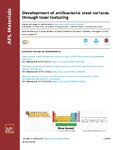Mostrar o rexistro simple do ítem
Development of Antibacterial Steel Surfaces Through Laser Texturing
| dc.contributor.author | Villapún, Victor M. | |
| dc.contributor.author | Pérez Gómez, Astrid | |
| dc.contributor.author | Wei, W. | |
| dc.contributor.author | Dover, L. G. | |
| dc.contributor.author | Thompson, Jonathan R. | |
| dc.contributor.author | Barthels, T. | |
| dc.contributor.author | Rodríguez, Jaime | |
| dc.contributor.author | Cox, S. | |
| dc.contributor.author | González, S. | |
| dc.date.accessioned | 2020-10-29T16:29:12Z | |
| dc.date.available | 2020-10-29T16:29:12Z | |
| dc.date.issued | 2020-09-22 | |
| dc.identifier.citation | Victor M. Villapún, A. P. Gomez, W. Wei, L. G. Dover, Jonathan R. Thompson, T. Barthels, J. Rodriguez, S. Cox, and S. González, "Development of antibacterial steel surfaces through laser texturing", APL Materials 8, 091108 (2020) https://doi.org/10.1063/5.0017580 | es_ES |
| dc.identifier.issn | 2166-532X | |
| dc.identifier.uri | http://hdl.handle.net/2183/26593 | |
| dc.description.abstract | [Abstract] The aim of the present study was to develop novel antibacterial touch surfaces through the laser texturing optimization of stainless steel. A wide range of laser fluence (2.11 J/cm2–5.64 J/cm2) and scanning interval (10 µm–30 μm) parameters were explored. The impact of surfaces with different patterns, wettability, and oxidation states on the antimicrobial behavior of Escherichia coli K-12 and biofilm hyper-producing Acinetobacter baumannii MAR002 was assessed. Modification of laser input enacted topographical changes with high scanning intervals leading to ordered surface patterns, while increasing the laser fluence to 5.64 J/cm2 created larger and less ordered plateaus and valleys. Texturing also drove a transition from a hydrophilic starting surface with a contact angle of 80.67° ± 3.35° to hydrophobic (138°–148°). Antimicrobial analysis and bioluminescence assays of E. coli, alongside biofilm forming test through A. baumannii MAR002 indicated the ability of laser texturing to produce effective bactericidal touch surfaces. No simple correlation was found between wettability and bacterial behavior, revealing that proliferation is dependent on roughness, oxidation, and wettability. For the conditions selected in this study, a laser fluence of 5.64 J/cm2 and a scanning interval of 10 µm showcased the lowest amount of recovered bacteria after 30 min. | es_ES |
| dc.description.sponsorship | This research was supported by Project Nos. 592 p-01216A and IJCI-2016-29524 (awarded to A.P.G.), funded by the Spanish Society of Infectious Diseases and Clinical Microbiology (SEIMC) and MINECO, respectively. This manuscript is part of Process Design to Prevent Prosthetic Infections (Grant No. EP/P02341X/1) | es_ES |
| dc.description.sponsorship | Sociedad Española de Enfermedades Infecciosas y Microbiología Clínica; 592 p-01216A | es_ES |
| dc.description.sponsorship | Reino Unido. Engineering and Physical Sciences Research Council; EP/P02341X/1 | es_ES |
| dc.language.iso | eng | es_ES |
| dc.publisher | AIP Publishing | es_ES |
| dc.relation | info:eu-repo/grantAgreement/AEI/Plan Estatal de Investigación Científica y Técnica y de Innovación 2013-2016/IJCI-2016-29524/ES/ | |
| dc.relation.uri | https://doi.org/10.1063/5.0017580 | es_ES |
| dc.rights | Atribución 4.0 Internacional | es_ES |
| dc.rights.uri | http://creativecommons.org/licenses/by/4.0/ | * |
| dc.subject | Biofilms | |
| dc.subject | Luminescence | |
| dc.subject | Antibiotics | |
| dc.subject | Scanning electron microscopy | |
| dc.subject | Laser ablation | |
| dc.subject | Colony counter | |
| dc.subject | Energy dispersive X-ray spectroscopy | |
| dc.subject | Antimicrobials | |
| dc.subject | Profilometry | |
| dc.subject | Bacteria | |
| dc.title | Development of Antibacterial Steel Surfaces Through Laser Texturing | es_ES |
| dc.type | info:eu-repo/semantics/article | es_ES |
| dc.rights.access | info:eu-repo/semantics/openAccess | es_ES |
| UDC.journalTitle | APL Materials | es_ES |
| UDC.volume | 8 | es_ES |
| UDC.issue | 9 | es_ES |
| UDC.startPage | 091108 | es_ES |
| dc.identifier.doi | 10.1063/5.0017580 |
Ficheiros no ítem
Este ítem aparece na(s) seguinte(s) colección(s)
-
GI- Quimolmat - Artigos [104]






